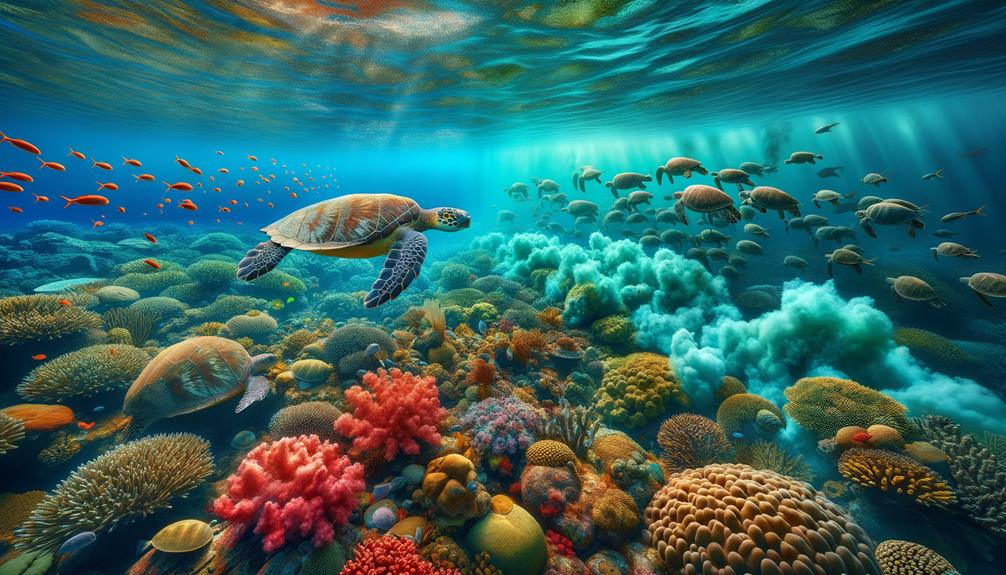I've learned that many common beliefs about turtle longevity are simply not true. Turtles don't live forever without proper care. They may show minimal signs of aging, but factors like poor habitat, lack of UVB light, and an improper diet can significantly shorten their lifespan. For instance, painting their shells or keeping them in small containers can cause harm to their health. Turtles have nerves and blood vessels in their shells, so drilling holes or binding them can be extremely painful. To ensure their longevity, turtles need a proper habitat, a balanced diet, and regular veterinary check-ups. To really understand how these gentle reptiles thrive, there's more to learn about their specific needs.
Key Takeaways
Turtles' slow aging is often attributed to their hard shells, but it's not that simple. In reality, turtles just don't show many signs of aging because they don't have certain chemicals in their bodies that accelerate aging in other animals.
Giving your turtle the right care is vital for a long and healthy life. This includes providing UVB light, which is often misunderstood, and a balanced diet. Many people think turtles are low-maintenance pets, but that's not true.
Not understanding how important UVB light is can actually shorten a turtle's life. And, surprisingly, turtle shells are living parts with nerves and blood vessels, so practices like painting or drilling can be harmful and painful for them.
Common Lifespan Misconceptions
Many people have misconceptions about turtles as pets, thinking they're low-maintenance and can thrive in small tanks. However, this couldn't be further from the truth. Turtles have specific needs that are often overlooked, leading to suffering and even death. A common myth is that turtles don't feel their shells. In reality, a turtle's shell is packed with nerves and blood vessels, making it a vital part of their anatomy. Drilling holes or tightly binding a turtle's shell can cause immense pain and harm.
Another misconception is that turtles can thrive in small tanks. Aquatic turtles require ample space to swim and move around, with a minimum of about 38 liters of water per inch of shell length. Most pet stores don't provide this, leading to unhealthy living conditions. Painting a turtle's shell is also a bad idea. It not only makes them more visible to predators but also prevents the absorption of essential UVB light, vital for their health. Misunderstanding these needs can lead to dying animals and contribute to the decline of various turtle species. Providing proper care is crucial for these remarkable creatures to live long, healthy lives.
Species-Specific Longevity

Turtles are known for their remarkable longevity, with some species living well over a century due to their unique biological traits. Their slow aging process is largely attributed to their protective traits, such as their hard shells, which offer a formidable defense against predators and greatly lower their mortality rates. This physical protection allows them to live longer without the constant threat of predation.
What's fascinating is that turtles, along with other reptiles like crocodilians and salamanders, show minimal signs of aging. They don't experience an increase in mortality risk as they age, unlike most other animals. Their ability to age slowly isn't just about physical traits; chemical factors also play a significant role. The absence of certain age-accelerating chemicals in their bodies contributes to their extended longevity.
Additionally, turtles take a long time to reach sexual maturity and have low external mortality risks, which further supports their slow aging process. Understanding these species-specific longevity factors is not only intriguing to biologists but also provides valuable insights into the mechanisms of aging that could one day benefit humans. As we learn more about how these long-lived creatures manage to survive for centuries, we can apply these lessons to our own lives.
Impact of Environment

When it comes to turtle longevity, their environment plays a crucial role. Clean water, suitable temperatures, and a proper habitat are vital for their health and lifespan. Even small changes in these factors can significantly impact how long a turtle lives.
Habitat Conditions Matter
Understanding how habitat conditions impact a turtle's health is crucial for their well-being in captivity. As cold-blooded animals, turtles rely on their environment to regulate body temperature. Proper habitat conditions make a significant difference in ensuring they live longer and healthier lives.
Shelter is vital for turtles. Their shells, which they cannot remove or abandon, need protection from harsh elements and predators. A well-structured habitat not only provides shelter but also mimics their natural environment, reducing stress and promoting well-being. Since habitat loss in the wild has already put many turtle species at risk, replicating their natural conditions in captivity is vital.
To create a thriving environment for captive turtles, consider the following essentials:
- Space: Aquatic turtles require about 38 liters of water per inch of shell length for proper swimming.
- UVB Light: Turtles need unblocked UVB light for calcium metabolism and overall health.
- Shelter: Providing hiding spots and varied terrain can reduce stress and mimic their natural habitat.
Water Quality Importance
Maintaining good water quality is crucial for a turtle's health and longevity in captivity. If the water quality is poor, turtles can develop severe health issues like shell rot and skin lesions, which can cause pain, discomfort, and even shorten their lifespan.
High ammonia levels from waste buildup in small enclosures can be particularly hazardous. Ammonia can cause respiratory distress and even damage the nervous system. Therefore, it's vital to keep the environment clean and monitor the water quality.
Insufficient water depth is another critical factor to consider. If a turtle can't fully submerge, its ability to regulate its body temperature and develop a healthy shell is compromised.
Filtration systems and regular water changes are must-haves. They help remove harmful bacteria and pathogens from the water, reducing the risk of infections. Incorrect water pH, temperature, and mineral content can disrupt a turtle's physiological processes, leading to metabolic disorders that can be life-threatening.
Temperature Regulation Effects
Turtles rely heavily on their environment to regulate their body temperature, making their habitat conditions crucial for their health and longevity. As ectotherms, they need external sources to maintain their body temperature, which means their well-being is closely tied to their surroundings.
Turtles have a unique combination of traits that contribute to their impressive lifespans. Their slow aging isn't solely due to their ectothermic nature, but their physical traits play a significant role. Their protective shells and natural armor help reduce mortality rates, enabling them to thrive even in challenging environments.
One advantage of being ectothermic is that turtles can conserve energy by relying on external heat, which may contribute to their slow aging. Their shells also offer significant protection, reducing predation and injury risks. Moreover, turtles' ability to maintain low mortality rates despite environmental fluctuations supports their long lifespans.
The relationship between thermoregulatory mode and aging rates is complex. While ectotherms, including turtles, show a wide range of aging rates, their negligible senescence is more closely linked to their protective physical traits and ability to endure environmental challenges. Understanding these factors provides insight into the secrets behind turtle longevity.
Myths About Care

Why do many people believe turtles can thrive in small spaces with minimal care? This myth has led to countless turtles suffering. Let's set the record straight and understand what proper care really means.
A turtle's shell is more than just a hard exterior; it's a living part of their body, rich with nerves and blood vessels. Painting a turtle's shell may seem harmless, but it exposes them to toxic chemicals and blocks essential UVB light absorption, which is crucial for their health.
Many assume turtles can thrive in tiny containers, but that's far from the truth. Aquatic turtles need large, deep enclosures to swim, explore, and stay active. Their habitat is vital, and neglecting it can lead to serious health issues.
Here's a quick comparison of common myths vs. facts:
| Myth | Fact | Importance |
|---|---|---|
| Small containers are enough | Turtles need large, deep enclosures | Ensures adequate space for swimming |
| Shells are just hard exteriors | Shells are part of their anatomy | Protects the turtle's overall health |
| Painting shells is safe | Painting exposes to toxic chemicals | Prevents harmful chemical exposure |
| Minimal care is adequate | Proper care is essential | Supports longevity and well-being |
| Cheap setups suffice | Proper habitat can be costly | Reflects true cost of responsible care |
Providing proper care and habitat for turtles might be challenging, but it's the key to their happiness and long life. Let's give these amazing creatures the life they deserve.
Misunderstood Biological Factors

Understanding proper care is only half the battle; we also need to address some common misconceptions about a turtle's biology. Many people don't realize how intricate and sensitive these creatures are. For instance, turtles can't just abandon their shells. Their shells are integral, containing nerves and blood vessels, allowing them to feel sensations.
Painting turtle shells might seem harmless, but it interferes with their natural camouflage and disrupts their absorption of essential UVB light, which is vital for their health. These factors can greatly affect a turtle's lifespan, especially for adult females who need optimal conditions for egg-laying and overall well-being.
Some key biological factors to keep in mind:
Turtles can feel through their shells due to the presence of nerves.
UVB light is vital for their health and vitality, especially over the years.
Turtles can't remove or abandon their shells; it's a vital part of their anatomy.
While proper care is essential, understanding these biological factors ensures that turtles live much longer, healthier lives. Misunderstanding these basics can lead to premature death, which is still a significant issue among pet turtles.
Proper Husbandry Practices

When it comes to ensuring a turtle's long and healthy life, good care practices are vital. I prioritize providing a balanced diet, maintaining the right habitat temperature, and scheduling regular health checkups. By taking these steps, I can significantly improve their overall well-being and lifespan.
Balanced Diet Essentials
Turtles require a diverse diet rich in proteins, vegetables, and occasional fruits to maintain optimal health and thrive. A well-balanced diet is crucial in preventing health issues like metabolic bone disease, a common problem in poorly cared-for turtles. By providing a varied diet, you ensure your turtle receives all the necessary vitamins and minerals.
Proteins can include insects, crustaceans, and occasional cooked meats. Leafy greens, carrots, and squash make great vegetable options. Fruits like berries or melons can be offered in small amounts as treats.
In addition to a balanced diet, proper tank maintenance is vital. Ensure your turtle's tank has effective water filtration and maintain an appropriate water temperature. Clean, filtered water helps prevent infections and keeps your turtle comfortable. Regularly check the water temperature to ensure it's not too hot or cold for your turtle's health.
Habitat Temperature Control
Maintaining proper habitat temperature is crucial for a turtle's health. As ectothermic creatures, they rely on external heat sources to regulate their body temperature. In my experience, improper temperature regulation can lead to serious health issues, including metabolic disorders and shell deformities.
To create an ideal habitat, you need to mimic their natural environment. This includes providing a basking area with a temperature range of 85-90°F and maintaining a water temperature of 75-80°F for aquatic turtles. Aquatic turtles also require a water depth of at least 2-3 times their shell length to swim and thermoregulate effectively.
A proper thermal gradient is essential, allowing turtles to move between warmer and cooler areas as needed. UVB lighting is also vital for their physiological needs, including shell and bone health. Humidity levels should be carefully regulated to prevent respiratory issues.
Regular Health Checkups
Regular health checkups are vital for ensuring your turtle's long-term health and catching potential issues early. As reptiles and amphibians, turtles require specific care to thrive, and regular veterinary check-ups can make a significant difference. By staying on top of your turtle's health, you're ensuring it lives a long, healthy life, free from preventable diseases.
A knowledgeable reptile veterinarian can guide you through the nuances of turtle care. There are three key aspects to focus on:
Proper nutrition is crucial for your turtle's overall health. A balanced diet is essential, and a veterinarian can help you determine the right foods for your pet.
Providing optimal housing is also critical. A clean, spacious enclosure with the correct water depth, basking areas, and UVB lighting is necessary for your turtle's well-being.
Monitoring your turtle's behavior is equally important. Regularly observing your turtle's appetite, behavior, and shell condition can help you identify health issues early.
Neglecting these aspects can lead to severe health problems, such as metabolic bone disease, respiratory infections, and shell deformities. Regular veterinary check-ups and proper care can go a long way in keeping your turtle healthy and happy.
Frequently Asked Questions
Can Turtles Live up to 500 Years?
Can turtles live up to 500 years? It's highly unlikely, according to verified studies. While some turtles can live over 100 years, claims of 500-year lifespans are unfounded and lack scientific evidence to back them up.
What Is the Number One Cause of Death for Turtles?
The number one cause of death for turtles is human activity, which has a devastating impact on their survival. Habitat destruction, pollution, and vehicle strikes are just a few examples of how our actions are harming these incredible creatures. It's heartbreaking to see turtles suffer due to our careless behavior.
Can Turtles Live for 1000 Years?
Imagine buying into a mythical tale. The idea that turtles can live for 1,000 years is simply a fantasy. The Galápagos tortoise, one of the longest-living species, tops out at around 120 years. So, no, turtles aren't going to live for a millennium.
What Allows the Turtle to Live for 100 Years?
Turtles can live up to 100 years due to their unique physiology and genetic makeup. Their hard shells protect them from predators, while their slow metabolism and negligible senescence help them resist aging. Additionally, turtles have low mortality rates, which contribute to their remarkable longevity.



